Art Fairs
At Frieze L.A., Get Ready to Be Soothed by Flowers, Still Lifes, Ceramics, and More Flowers
In these distressing times, dealers are turning to the some tried and tested art subjects and materials.
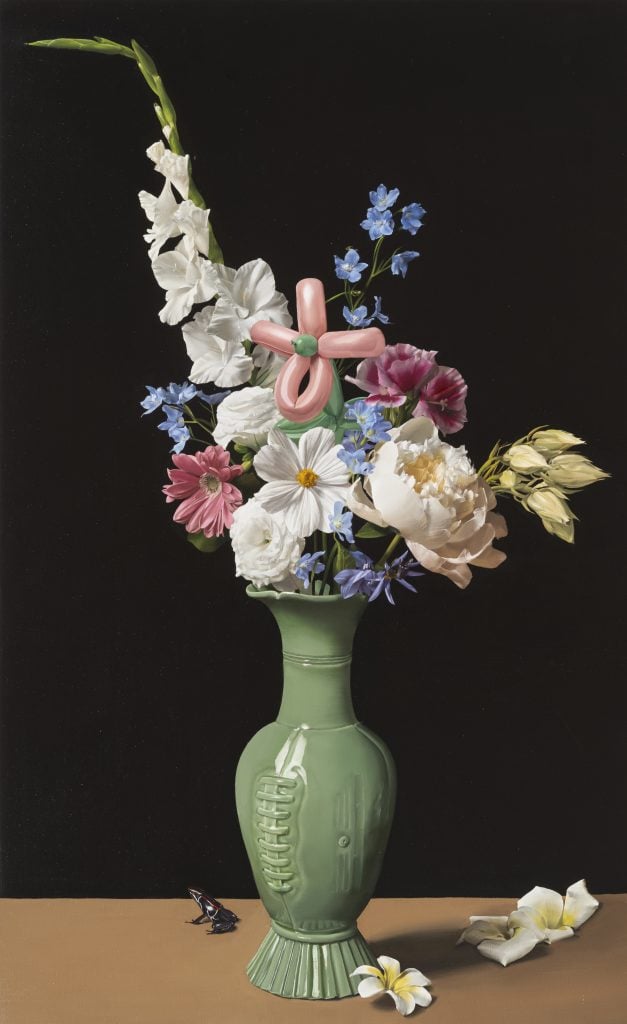
In times of uncertainty, artists have historically returned to conservative forms of art-making—“the holy trinity of portrait, still life, and landscape,” London-based advisor Brandy Carstens recently told me. For example, following the traumatic upheaval of World War I, the likes of Picasso, Léger, and de Chirico momentarily retreated from the avant-garde into the comforts of familiarity. “After making radical work,” Carstens explained, “all of a sudden they were painting orderly classical figures.” Today, the art world is showing similar signs of distress, if the dominant market trends heading into the next edition of Frieze L.A. are any sign.
With the stresses of the sales slumps and inflation spikes of the last year, the mood is risk-averse, and dealers have shied away from works that might bring current politics or polarizing topics into the booth, instead gravitating toward reliably soothing, topically-neutral imagery of flowers, trees, and more flowers.
Below is a brief guide on where these trends can be found at Frieze L.A.—which, to be clear, is an indicator of what kinds of works are being presented on the market, and not necessarily what subjects artists have suddenly started making or pursuing. The two, however, often coincide.
Landscapes and Nature Scenes
This year, “landscapes are the new figuration,” says L.A. collector Laurie Ziegler. Figurative paintings are still very much being produced, but for galleries in L.A. and well beyond, the bucolic escapism of dreamy sunsets, rolling hillsides and lush gardens has the art world in a chokehold. Artists not typically associated with nature and flowers have added them to their visual repertoire, including Doron Langberg at Victoria Miro in Venice, Wanda Koop at Night Gallery in LA, and recent shows of Jordan Casteel at Casey Kaplan in New York.
Casteel, an artist celebrated for her emotive portraits of quotidian Black life in New York City, began painting floral landscapes around the time she moved to upstate New York in 2021. Both types of work appear in Kaplan’s solo booth at Frieze LA, showcasing a new phase of Casteel’s practice undoubtedly shaped by her pastoral settings. These newer works are overall less bustling, less focused on the material details of the backdrop than atmospheric ones; background objects are abstracted, cropped, or unfinished, while light is more present, robust and pronounced. Mid- to large-scale pieces start around $300,000.
Similarly, in a solo booth by Stephen Friedman, Brazilian artist Luiz Zerbini’s canvases are saturated with tropical colors and plant life. And in Anat Ebgi’s three-person presentation, Palestinian-American artist Jordan Nassar’s embroidered, mountainous landscapes employ the Palestinian cross-stitch technique tatreez alongside other Levantine craft traditions.
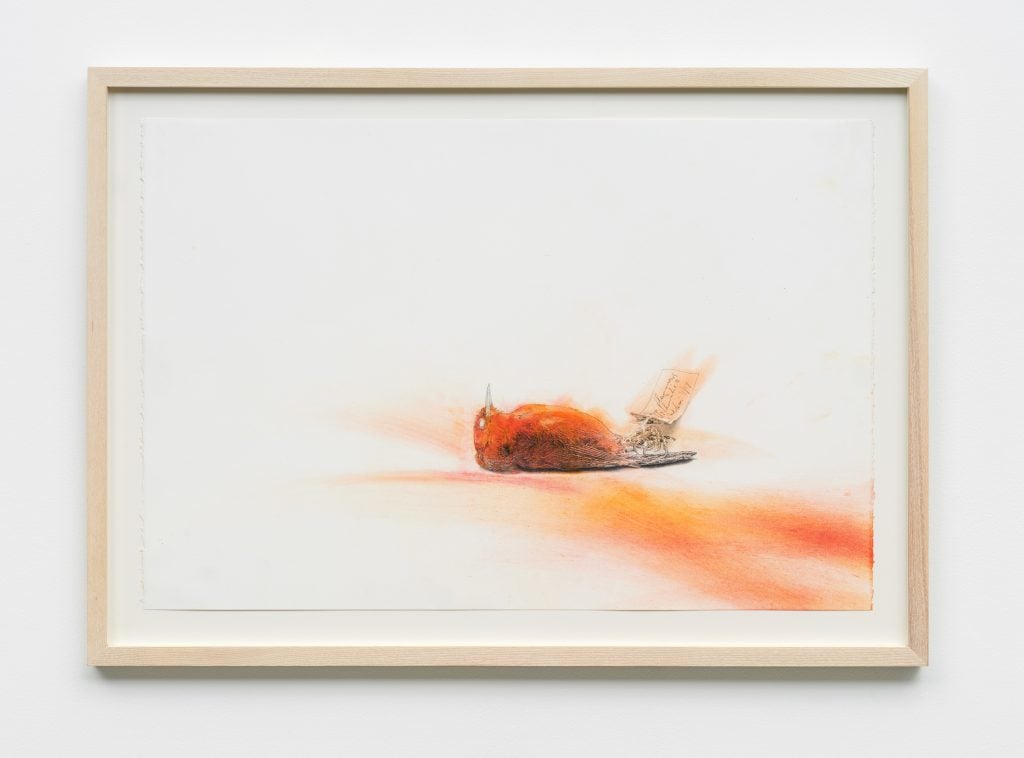
Andrea Bowers, The Dead Silence of Extinction (Moloka’i Creeper, last confirmed sighting 1963, HI, scientific specimen preserved at Auckland Museum’s Natural History Collection) (2023). Photo: Brica Wilcox. Courtesy of the artist and Vielmetter Los Angeles.
Vielmetter’s two-artist presentation includes Whitney Bedford’s nine-panel painting Veduta (Vulliard Jardin Publics), (2023–24), an homage to Nabi painter Edouard Vuillard’s decorative tendencies (it is being offered for $300,000). The leisurely park scenes of his 1894 painting Jardins Publics appear almost as a wallpaper, overlaid with bright orange and red weeping willows symbolic of ecological urgency. They also match the urgency of Andrea Bowers’ The Dead Silence of Extinction series, drawings of dead birds tagged and labeled as natural history museum specimens, that will appear alongside (each work is priced at $42,000).
And as part of the Focus section for emerging artists at Frieze LA, curated this year by Essence Harden, the visual arts curator at the California African American Museum, L.A. gallery Sow & Tailor presents new paintings by Javier Ramirez. In sheer, dripping acrylic, he layers bonsai trees, lawn mowers, and the domestic outdoors as an homage to the Japanese and Latino landscapers who’ve historically shaped LA’s greenery.

Javier Ramirez, Walk thoughts #2: Buzzy (2024). Photo: courtesy of Sow & Taylor.
In fact, urban landscapes that layer the city’s cultural iconography, especially by Chicano artists, is one of the most important things happening in L.A. art right now—a focal point of recent biennials and current shows at Charlie James and Jeffrey Deitch. It’s surprising and disappointing that such work is less visible at the fair.
Flowers and Still Lifes
Flowers feature prominently in both landscapes and still lifes, but the two genres have important distinctions. Landscapes, regardless of their temporal or geographic specificity, are generally interesting to people because they’re pretty. The details of a still life, on the other hand, are inseparable from biographical or allegorical readings—we look at the placement of each object and expect it to mean something. They have been everywhere at recent fairs.
In this vein, Awol Erizku’s photographs on view in a solo booth with Sean Kelly capture the artist’s notions of Afro-esotericism, an aesthetic of cultural continuity between Africa and its diasporas. Often captured against a monochrome backdrop, his scenes may include African masks, Nefertiti busts, a bottle of Aunt Jemima breakfast syrup, or cash, plus allusions to fellow artists David Hammons, Marcel Duchamp, or Andy Warhol that are simultaneously reverent and critical of art history. (Flowers and female nudes, perennial subjects of interest, also intermittently appear.)
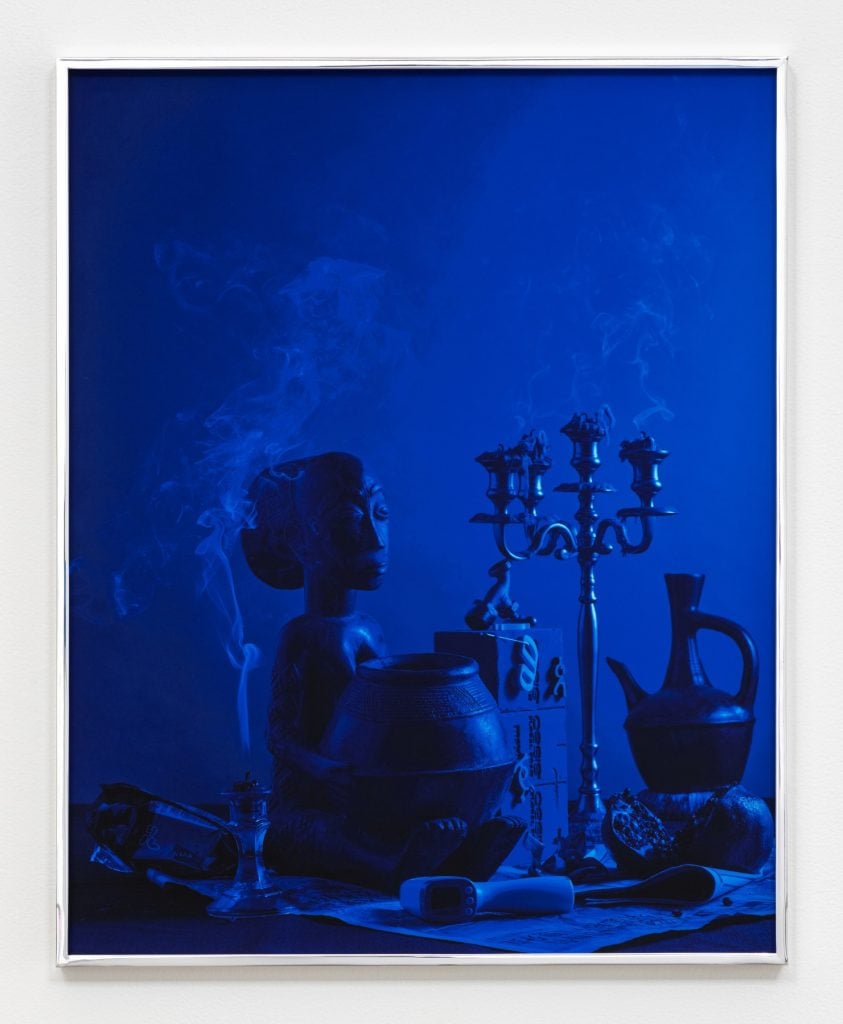
Awol Erizku,Moonlight Freestyle (2021). Photo: © Awol Erizku, courtesy of the artist and Sean Kelly, New York/Los Angeles.
Brazilian artist Paulo Nimer Pjota works in a conceptually similar vein, layering elements of contrasting graphic and historical references in his paintings. His older works deconstructed and reassembled the still life through the language of graffiti, placing photorealist ancient pottery on canvases that emphasized texture over image, like the surface of a blank wall. His more recent works, included in Mendes Wood’s group booth, are decidedly softer, where both the pottery and canvas are now filled with flowers.
Artist Stephanie Syjuco’s research-based practice often mines photographic archives as a way of recontextualizing Filipino history. In Silverlens’ two-person booth, her new black-and-white prints collage images of decorative plants with faint texts alluding to civil unrest, both pulled from the since-shuttered Manila Chronicle newspaper. According to the gallery, the juxtaposition shows “how power disguises itself in decorative veneer.”
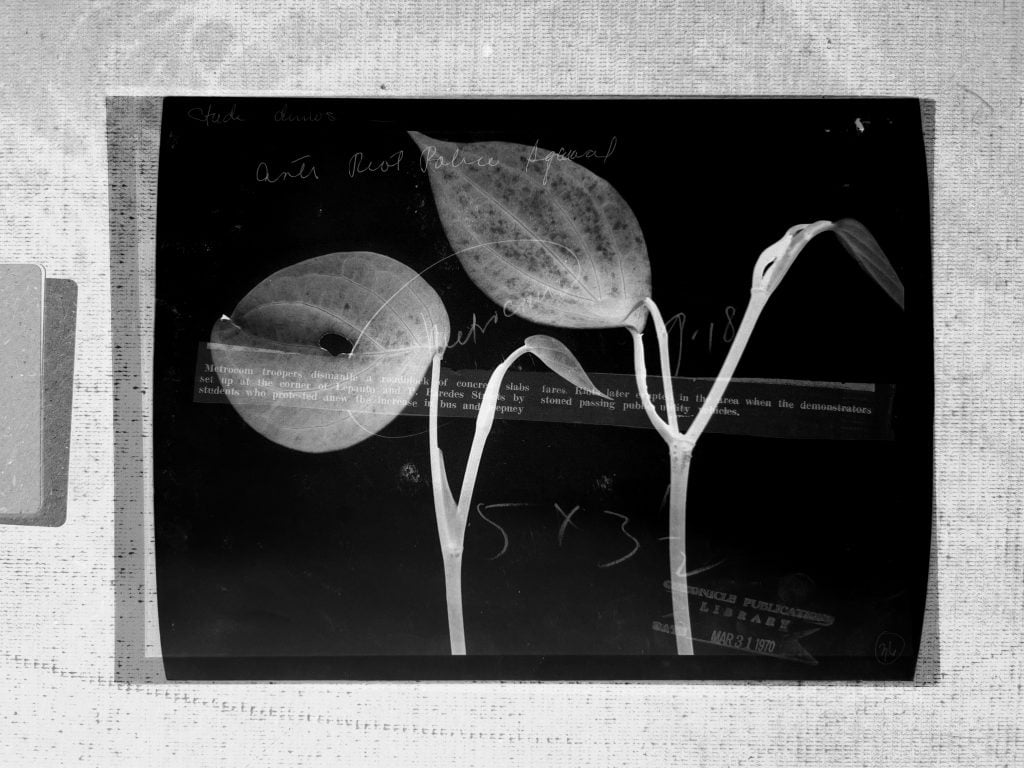
Stephanie SyjucoForce Majeure 5 (Propagation / Troopers) (2023). Photo: courtesy of the artist and The Lopez Museum and Library.
Another Focus presentation is Matthew Brown’s solo booth of works by Kent O’Connor, a painter known for depicting objects in his studio on perspective-flattening tables. And back in the general section of the fair, Seoul-based Gallery Hyundai’s booth features “approximately 20” works by emerging photorealist Kim Sung Yoon, whose paintings check multiple trending boxes. His still life (tick) makes historical reference (tick) to the Old Masters idea of the impossible bouquet, arranging flowers (tick) that would normally never bloom in the same place at the same time. The flowers are sourced from online stock imagery and digitally assembled in vases (tick) by fellow artist Yoo Eui Jeong, whose ceramics merge classical forms (tick) with contemporary graphics and logos. According to the gallery, Kim’s canvases embody a “convergence of multiple contexts” and “eerily recognizable landscapes” (tick and tick).
Sculptural Vessels and Busts
This leads us handily into our final trend to spot at Frieze LA: ceramics, the natural, classical, sculptural companion to floral still life paintings. Hyundai’s booth, for example, will also feature the actual vases by Yoo depicted in Kim’s paintings.
Allison Schulnik’s solo booth with L.A. gallery The Pit shows her textural oil paintings of arranged desert flora alongside new glazed porcelain vessels, priced between $12,000 and $18,000. Totemic and asymmetrical, their surfaces are covered with the wildlife of her home in the Mojave—coyotes, snakes, and butterflies. Vessels adorned with other tiny ceramic animals is a tradition of California Funk artists like Melvino Garretti, whose colorfully glazed pots prominently feature in Parker Gallery’s group booth.
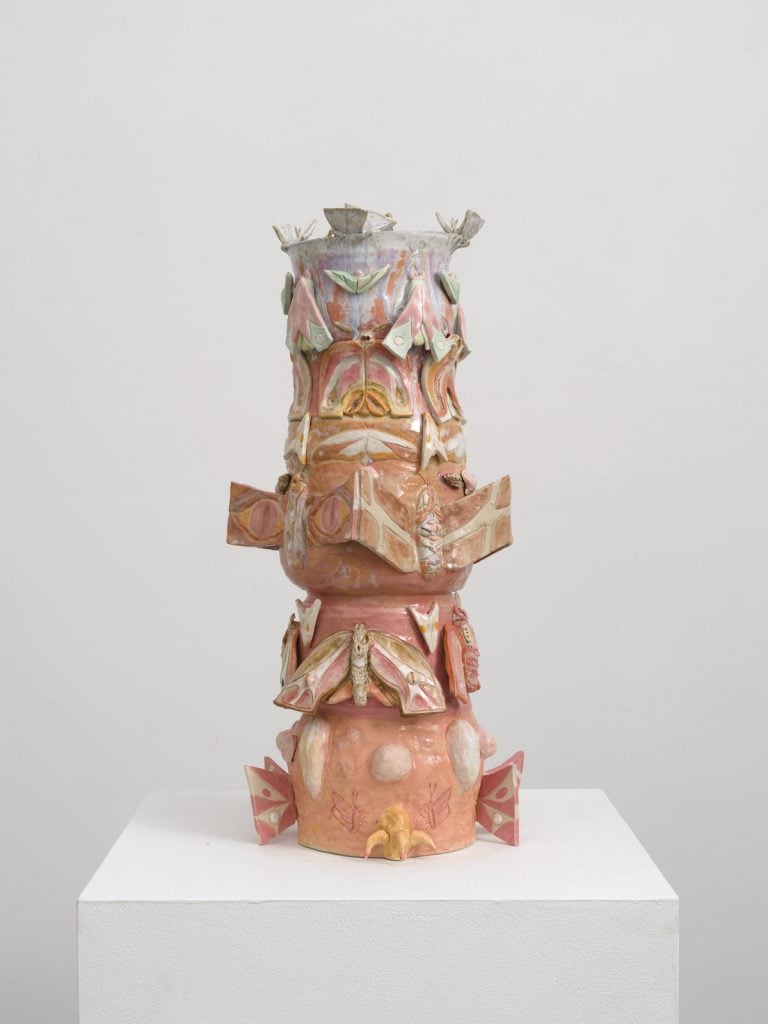
Allison Schulnik, Pink Moth Pot (2023). Photo: Jeff Mclane.
The classical bust also emerges as an extension of the portrait, in booths such as Dominique Gallery’s solo presentation of Mustafa Ali Clayton, an L.A. painter-turned-sculptor. His sculptural earthenware portraits of Black figures, stylized with cartoonishly childlike rounded ears and button noses and finished with a high-gloss ebony glaze, feature quotidian cultural markers like the colorful beaded braids of Sofia (2022).
At Kasmin, multidisciplinary artist vanessa german presents a new series of works for the first time at Frieze LA. Her plaster busts are adorned with rose quartz, a pink crystal whose alleged healing properties align with the artist’s spiritual ethos of restorative justice, love and redemption. Combining elements of folk art and mysticism, the rose quartz, alongside pyrite, blue lapis and chalcedony, takes on gem- and bead-like qualities, covering the surface of the busts with a mosaic of patterns. A handful of these works will include accompanying prayers recorded by the artist, incorporating the ritual and performance elements of her practice.





